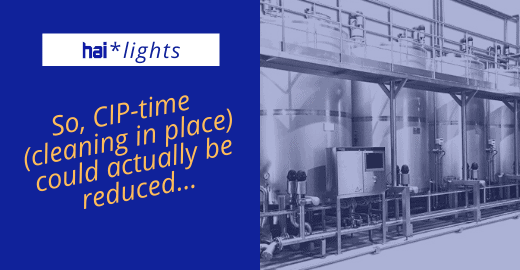CIP-time (cleaning in place) reduced…
So, CIP-time (cleaning in place) could actually be reduced….
A Food manufacturer recently discovered that the CIP-tank cleanings (cleaning-in-place) took 5 minutes longer than before. Guess what?
They found lime-scale deposits inside the tanks. Therefore, it took a little longer to reach the required CIP-temperature. After the lime-scale deposits were removed, the CIP-duration decreased with 5 min. Thus, over 4 hours extra production hours per week became available.
CIP duration trending reports in the HAI smart4industries software triggered this investigation.
It involved 15 tanks, so it amounted to 15×5 = 75 minutes of unnecessary lost production time each CIP cleaning. The tanks were cleaned 3 to 4 times a week, resulting in 75 min x3,5.=262 min. per week, representing more than 4 hours extra production time per week.
HAI*lights: practical examples of smart use of factory data
A Food manufacturer recently discovered that the CIP-tank cleanings (cleaning-in-place) took 5 minutes longer than before. Guess what?
They found lime-scale deposits inside the tanks. Therefore, it took a little longer to reach the required CIP-temperature. After the lime-scale deposits were removed, the CIP-duration decreased with 5 min. Thus, over 4 extra production hours per week became available.
CIP duration trending reports in the HAI smart4industries software triggered this investigation.
It involved 15 tanks, so it amounted to 15×5 = 75 minutes of unnecessary lost production time each CIP cleaning. The tanks were cleaned 3 to 4 times a week, resulting in 75 min x3,5.=262 min. per week, representing more than 4 hours extra production time per week.
CIP Reports
In the HAI smart4industries software all CIP-cleaning activities are automatically logged. Cleaning execution and frequency is matched against schedules, Moreover, there is a complete logging and reporting of CIP-duration and CIP-temperatures, next to reports on consumption of utilities, water and chemicals.
These data comes from external sources: PLC controllers, historian, SCADA, temperature sensors, etc. Additionally, data can be completed manually.
CIP trends and deviations
By making CIP-information accessible (like CIP-steps, CIP-temperatures, CIP-consumption and CIP–duration), manufacturers gain insights in trends and deviations. This is primarily important for food safety purposes.
Shorter CIP duration and decrease in CIP consumptions
Moreover, these reports and trends help to identify cost saving opportunities. For instance, this may apply to CIP-related reduction of water and utilities consumption or chemicals consumption. Also it provides opportunities to investigate if CIP-duration can be shortened.
The HAI smart4industries software turns out to be an adequate tool to monitor CIP food safety and cost effectiveness.
CIP-cleaning: part of a bigger picture
CIP-cleaning is not an isolated subject: it is part of a greater whole. For instance:
– What about microbiology test results?
– What about product quality?
– What about operator QA control records?
Therefore, it is convenient that information about CIP-cleaning is stored in the HAI smart4industries database along with data on product quality, microbiological test results of the (external) lab, processing conditions and production data. This way manufactureres gain an overal view on all measurements that are relevant for quality and production.
Get inspired
Interested in more best practices of smart use of factory data, especially in the Food Industry?
Get inspired by successes of others when it comes to OEE, quality, positive release, golden batch, CIP-cleaning, operator support, factory data anaytics, in-line measurements, factory dashboards… and much more.
Do not miss it and follow us on LinkedIn:








